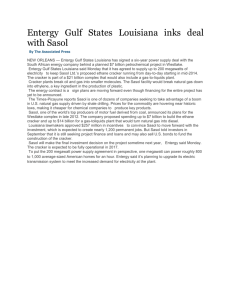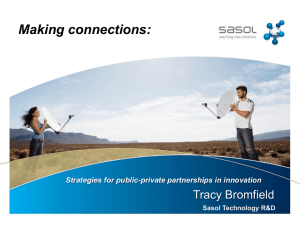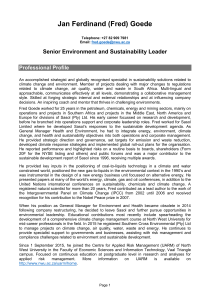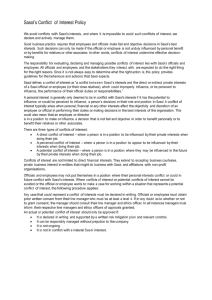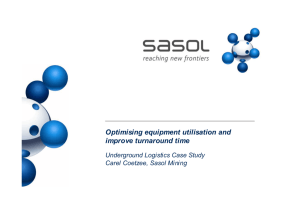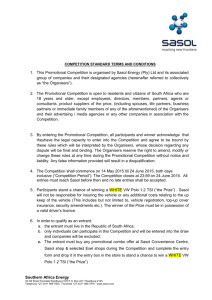Final Techvoice April 2015
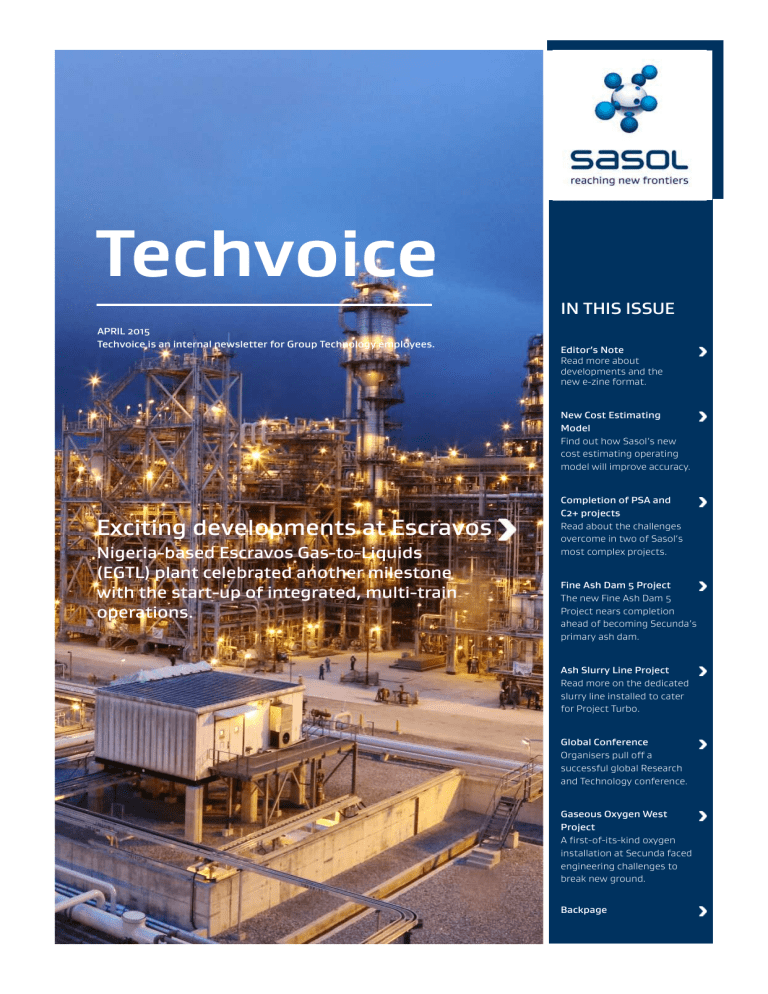
Techvoice
APRIL 2015
Techvoice is an internal newsletter for Group Technology employees.
Exciting developments at Escravos
Nigeria-based Escravos Gas-to-Liquids
(EGTL) plant celebrated another milestone with the start-up of integrated, multi-train operations.
IN THIS ISSUE
Editor’s Note
Read more about developments and the new e-zine format.
New Cost Estimating
Model
Find out how Sasol’s new cost estimating operating model will improve accuracy.
Completion of PSA and
C2+ projects
Read about the challenges overcome in two of Sasol’s most complex projects.
Fine Ash Dam 5 Project
The new Fine Ash Dam 5
Project nears completion ahead of becoming Secunda’s primary ash dam.
Ash Slurry Line Project
Read more on the dedicated slurry line installed to cater for Project Turbo.
Global Conference
Organisers pull off a successful global Research and Technology conference.
Gaseous Oxygen West
Project
A first-of-its-kind oxygen installation at Secunda faced engineering challenges to break new ground.
Backpage
Techvoice l April 2015
EGTL TRAIN START-UP
Global milestone for Escravos Gas-to-Liquids project
View of EGTL from tanks.
The emerging global Gas-to-Liquids (GTL) industry celebrated another major achievement in March with the successful, fully-integrated operation of the two GTL trains at the Nigerian-based Escravos Gas-to-Liquids
(EGTL) project.
The achievement is no small feat and pushes forward the growth of the sector, in which Sasol plays a leading role.
With both trains online simultaneously for the first time, the EGTL facility was able to convert approximately 70 per cent of the available feed-gas to high value, onspecification GTL products.
According to the team on site – which provide Single
Point Licensor services on a rotational basis at the remote Niger Delta site – the EGTL journey has been both trying and rewarding.
“Although the first single train start-up and production of on-specification product was achieved in June 2014, the simultaneous operation of both trains is significant since it required that all core process and overall facility utility systems were fully available and functionally integrated,” said Pauli Baumann, Group Technology
Senior Manager: Technology Licensing.
2
HOW IT WORKS
Upstream of the Sasol ® Low Temperature Fischer-Tropsch
(LTFT™) units, the Syngas Generation unit – comprised of two Haldor Topsøe Auto Thermal Reforming trains
– converts natural gas, steam and oxygen into synthesis gas or
‘syngas’. The syngas is converted to liquid products in the
Sasol ® LTFT™ units, which in turn is converted into Naphtha and
Diesel in a Chevron Product Work Up unit. This integrated value chain is known as the proprietary ‘Sasol ® Slurry Phase Distillate
(SPD™) Process’.
“Normally, during a single train start-up, it is quite simple to close the gas loop from the Sasol ® LTFT™ unit back to syngas generation. When starting up the second train the effluent gas composition needs to match that of the first train before introducing this gas into the gas recycled to Syngas Generation.
“The first train also supplies a large portion of the utilities needed to start-up the second train, so it is critical that the first train is kept as steady as possible to avoid destabilising the entire plant – quite an intricate feat,” said Johan Malan,
Manager: Syngas Generation, Concept and Licensing
Engineering.
Read more on Sasol LTFT™ Units.
Techvoice l April 2015
1998
Pre-feasibility stage
2002
Front-end engineering design
(FEED) stage
2005
Construction contract awarded
2014
Beneficial operation and start-up success of the individual trains
2015
Successful integrated multitrain operations
ABOUT EGTL
Escravos GTL is a two-train GTL facility designed to convert 325-million cubic feet of natural gas per day into 33,000 barrels of GTL products using proprietary Sasol ® SPD™ technology.
The EGTL project was developed by Chevron
Nigeria Limited and the Nigerian National
Petroleum Company with Sasol licensing the core technology and holding a minority interest in the venture.
The EGTL facility represents Sasol’s second successful international GTL project – the first is the pioneering Qatar-based ORYX GTL project – and adds impetus to the emerging global GTL industry.
Find out more about EGTL.
EGTL during construction.
EGTL from tanks.
LIFE IN NIGERIA
Working and living in Nigeria, and a remote area of the country, has been an interesting experience for the team.
“When heading to the facility you fly over miles of jungle and then suddenly out pops this world-class facility. It’s quite surreal. It’s also been challenging – working for four weeks straight, seven days a week and
12 hours a day while getting accustomed to a constantly changing workforce as teams rotate in-and-out. But the reward lies in being part of what is a once-in-a-lifetime career opportunity,” said Johan.
Group Technology extended its thanks and congratulations to the
Technology Licensing team who had the privilege of taking ‘this epic effort over the line, after the massive contributions from the teams and individuals that paved the way over so many years before’.
“Without the ‘One Sasol’ mind-set, the successes on the Escravos Gas-to-
Liquids project would not have been achieved. We also thank the support personnel and families at home, as well as our GTL Operations Centre of
Expertise (CoE) colleagues seconded to Chevron. This achievement demonstrates that our proprietary Sasol ® SPD™ technology can be deployed in the most demanding environments. It is also a testament to the perseverance and tenacity of our people,” Pauli added.
CONTACT
Johan Malan,
Manager: Syngas Generation, Concept and Licensing Engineering
Tel: 011 344 3341 e-mail: johan.malan2@sasol.com
Pauli Baumann
Senior Manager: Technology Licensing
Tel: 011 344 2799 e-mail: pauli.baumann@sasol.com
3
Techvoice l April 2015
4
EDITOR’S NOTE
Communication – always a priority
KATHERINE STREET PROJECT
Here is the latest update on the Katherine Street
Project, our new global headquarters in Sandton,
South Africa.
We are very excited to get feedback on the new e-zine ‘Techvoice’ March edition.
Using Google Analytics, we can track:
• How many people are reading ‘Techvoice’ and returning to read it again.
• In which countries people reading
‘Techvoice’ are based.
• How many minutes people are spending per page and article.
To date, hundreds of unique readers are engaging ‘Techvoice’ and we are excited to see its traction. This is an important insight into who is reading the e-zine and how they are using it. We will share more data and stats over the coming months, so watch this space.
Note: With the new Google Analytics in place – watch which sites you visit – we are able to track your website activity.
Utilising Google’s Behaviour Flow feature we can see which pages are viewed the most – allowing us to optimise and tailor the content. Remember to stick to the rules and regulations enshrined in our information management policy.
COMMUNICATIONS UPDATE
In general, the Public Affairs team is hard at work developing plans to keep the
Group Technology stable and staff updated and informed – and a strategy is being developed to address your communications needs. If you have any queries, feel free to contact us or send us your input on improving the way we keep you informed.
Best,
Karin Kleynhans
Editor
CONTACT
Karin Kleynhans, Group Technology: Senior
Manager, Public Affairs
Tel: 011 344 0331 e-mail: karin.kleynhans@sasol.com
The reduction of our leased office portfolio across Johannesburg, and a move to a more modern and space-efficient building that will positively impact productivity, will yield significant cost savings – a key outcome of Project
Phoenix. However, the dramatic decline in the international crude oil price continues to impact our cash flow, so we have re-evaluated the scope and timing of the Katherine Street Project deliverables.
Our project mandating committee, supported by the Group Executive
Committee, recently approved a number of cost reductions to contribute towards the Group’s Response Plan efforts, while ensuring that the Katherine
Street building remains a great place to work.
Delayed
The following value-add facilities building will be delayed in fit-out and roll-out:
• Innovation centre.
• Crèche.
• Stakeholder entertainment and engagement areas.
• Seventy-seater auditorium.
We are also reducing the budget for office furniture, and have streamlined and optimised the project structure to ensure that overall costs are curtailed to the essential.
Milestones
Since December 2014, the following highlights featured:
• Progress in finalising the look and feel conceptual designs for the interior and landscaping.
• The layouts for 14 of 18 floors have been prepared ahead of schedule and will be approved shortly.
• The low-level network design has been certified by Cisco, with the final design for voice-and-data cabling progressing ahead of schedule.
• Progress was made with detailed technology, workplace design and commercial processes.
• Integration with the Real Estate Services team is ongoing to ensure alignment on the final relocation planning as well as the Katherine Street operating and service delivery model.
• The structural construction of the seven basement floors and the ground floor has been completed.
On Thursday, 23 April, we shared the building block and stack, and interior and work setting design – showcasing what is a real architectural achievement. Sasol looks forward to standing out against the Sandton skyline in only 16 months’ time.
Fay Hoosain
Senior Vice President, Office of the President and CEO
Article on the Katherine Street Project in ‘Engineering News’.
Techvoice l April 2015
ENHANCING ACCURACY
New cost estimating operating model adopted
Sasol has adopted a new cost estimating operating model to provide more accurate capital cost estimates, insurance replacement value and validation estimates to capital projects and business stakeholders that are reflective of current market conditions.
“We believe that this new operating model will provide more accurate cost estimates, together with the various methodologies that are used within the department,” said
Beno van Waveren, Senior Manager: Estimating. The model also enables efficient governance checks on estimates submitted by service providers, other business units and engineering companies. “This new approach improves inhouse understanding and application of estimating principles to support project teams when evaluating cost discrepancies for scope variations, claims and compensation events,” Beno added.
estimates; supports Databank on key FEED budget quotes; and trend analysis.
Support Estimating: Has a focus on supporting the evaluation of compensation events for the project manager or construction manager; supports cost and bid analyses; performs conceptual, basic and semi-definitive estimates for
Tier 4, Tier 5 and small projects; supports Databank on key small budget quotes; and reconciles Tier 4 and Tier 5 with actual versus estimate costs.
Insurance Estimating: Compiles an annual basis insurance and replacement estimates and maintains Sasol Fixed Asset
Registers.
ADDITIONAL BENEFITS
This new model also enhances the application of the various estimating methodologies practiced in the Cost
Estimating department, including: Capacity, equipment-factored and semi-definitive estimates for
Capital Projects of all tiers, capital value and technology maturity. The approach defines the future need on systems, indices and tools and tests their applications.
Conceptual/
Estimating
Studies
Estimating organisation design
FEED
Estimating
Support
Estimating
Insurance
Estimating
QC
DESIGN
The model’s functional design allocates resources into a set of four distinct focus areas and groupings, which are:
1. Conceptual Estimating.
2. Front-end engineering design (FEED) Estimating.
3. Support Estimating and Insurance Estimating.
4. Internal quality control and benchmarking functions run across these main groupings.
The main suites of software used in the estimating function are:
• Aspen Capital Cost Estimator (ACCE) and Cost Estimating
Suite of Programmes (CESP) for studies and feasibility estimates.
• Cleopatra and CESP for FEED Estimates.
• CESP for small projects and Tier 4 and Tier 5 estimates.
Conceptual Estimating: Has a specialist focus on pre-Gate 1 studies (Tier 1-3), all capital and phase estimates up to Gate 3, estimate reconciliation between previous gates including
Gate 3 and strong process make-up to ensure we can meet the challenge to process scope and study proposals.
“The effectiveness of the Estimating Services group is highly dependent on the quality of inputs, so monitoring of the minimum input data is critical and special focus to minimise re-work is being done on some estimates,” Beno added, saying the operating model was set to revolutionise estimating work across the business value chain.
FEED Estimating: Has a specialist focus on order-ofmagnitude and semi-definitive estimates (Tier 1-3); accuracy; estimates tracking on major projects; estimates reconciliation between Gate 3 and Gate 4; conducts material take-off (MTO), estimate co-ordination, over-the-fence build-own-operate evaluation; validates and checks consistency on basic FEED
CONTACT
Beno van Waveren
Senior Manager: Estimating
Tel: 011 344 0003 e-mail: beno.vanwaveren@sasol.com
5
Techvoice l April 2015
TWO KEY PROJECTS REACH COMPLETION
High bar set with completion of PSA and C2+ projects
Group Technology has displayed its revolutionary project philosophy, global benchmarks and ability to solve challenges with the completion of two complex projects, the C2+
Recovery Project and the Pressure Swing Adsorption (PSA)
Efficiency Upgrade Project.
A SERIES OF ENGINEERING FEATS
C2+ Recovery Project.
COMPLEX C2+
The C2+ Recovery Project – which entails the recovery of ethane and heavier hydrocarbons from natural gas – consists of two similar plants, integrated into the cold separation plant’s east and west units. Although the integration of existing expensive equipment – such as compressors and distillation columns – has reduced the project costs, it has also increased the complexity of the plant. Each plant has one natural gas pre-treatment plant and two separation and recovery modules, with one in each of the two phases at each unit. This amounts to four modules in total.
Both projects have set new standards for South Africa’s engineering industry through innovative interventions, implemented to solve challenges encountered along the way.
Challenge
The challenge of achieving stable operation for the C2+
Recovery Project was posed to the team after the signing of the ‘ready for operation’ status. “The plant could not be operated in automatic mode, as intended. The design intent was that a discernible liquid level was to form in a separation drum and to be controlled automatically as part of the control philosophy of the plant,” said Anton Stafleu,
Capital Projects: Project Manager, C2+ Recovery Project.
PSA EFFICIENCY UPGRADE PROJECT
Over 75 per cent of the PSA plant design had to be constructed off-site as complete modules and later brought to site. This was a complex, first-of-its-kind project where the modular construction philosophy represented a major percentage of the overall construction. The majority of the modules were handed over at the 75 per cent complete mark, at the fabricators’ construction sites.
The above-mentioned liquid level did not form. Following an investigation into the root cause of this problem, the team found conditions in the drum were too close to the critical point, and adequate separation between the liquid and vapour did not take place. A regroup followed and
Group Technology, Sasol Synfuels Operations, Linde and
Proconics worked together to develop an engineering solution. “After considering many alternatives, the proposed solution was to lower the operating pressure and to move away from the critical point in the separation drum. The plant was modified with additional instrumentation on phase three and the proposed solution was successfully demonstrated in August 2014,”
Anton added.
The PSA Upgrade Project started about five years ago after a need to reduce hydrogen losses, as a result of the declining efficiency of the current PSA at the Secunda Synfuels site was identified. Thabu Grobler, PSA Project Manager for Capital
Projects, said the PSA Upgrade Project qualified as both a greenfields and brownfields development, contributing to its complexity.
The two plants from the C2+ Recovery Project achieved stable operation in January and February this year.
“The new equipment had to be integrated into the existing running plant which required some upgrade work to the existing and operational off-gas compressors and control systems. This was a steep learning curve for all, but thanks to everyone’s efforts, the benefits of this construction philosophy was realised in all the main areas of the project, namely quality, schedule and cost,” Thabu explained.
C2 natural gas pre-treatment plant.
6
Techvoice l April 2015
SMOOTH SAILING
The project teams for both projects worked under high pressure and often challenging circumstances to achieve successful project completion.
Anton said although he would like to have avoided the experience of realising that a new plant was not working as expected, the dedication and commitment from the C2+
Recovery Project team was admirable. “The project team is thanked and commended for their effort and tenacity to live out the Sasol values under challenging circumstances. It has been a great learning experience and has shown that a multidisciplinary approach to complex projects is how we should tackle similar projects,” said Anton.
Alistair Hughes, Plant Support Engineer in the Gas Circuit, who was responsible for supporting the commissioning and startup of the units for the C2+ Recovery Project, said a large team was involved in the project, including the Group Technology projects team which worked closely with the Sasol Synfuels’
Operations and Technical Support teams.
“Significant challenges were observed during the start-up of the C2+ Recovery Project due to some concerns which arose from the initial engineering. A dedicated effort from all the teams helped to resolve these complex issues at a very late stage of the project cycle,” Alistair explained.
Lizelle Meyer, Senior Control Engineer on the PSA Upgrade
Project, said it was an engineering success that the PSA
Upgrade Project Outside Battery Limit (OBL) was commissioned without the contractors presence on site. “The success of this task was a collaborative action between Sasol
Synfuels’ Operations and Group Technology. The plant was started up within schedule due to the dedication of each member of the team,” said Lizelle.
Ken Sarman, a Senior Process Engineer, said working with such a diverse and experienced engineering team made execution of a complex and integrated plant an easy task.
“What I have learnt is that working on a brownfields site always adds a level of complexity and that one should plan for it. With the PSA unit, multiple stakeholders were affected and effective and timeous communication proved essential.”
CONTACT
Anton Stafleu
Capital Projects: Project Manager, C2+ Recovery Project
Tel: 017 619 3733 e-mail: anton.stafleu@sasol.com
Thabu Grobler
Capital Projects: Project Manager, PSA Upgrade Project
Tel: 017 619 2928 e-mail: thabu.grobler@sasol.com
Christie van Schalkwyk
Capital Projects: Engineering Manager, C2+ Recovery and
PSA Upgrade Projects
Tel: 017 619 2481 e-mail: christie.vanschalkwyk@sasol.com
PSA Upgrade Project team. Back row, from left: Kuben Kistan (PSA Commissioning Manager), Michael De Villiers (PSA Electrical Lead),
Jacques Strydom (Principal Specialist Process Control), Thabu Grobler (PSA Upgrade Project Manager), Ken Sarman (PSA Process Lead),
Gideon Keulder (Chief C&I Technician, GC), Pieter Venter (Production Foreman), Nico du Plessis (PSA Construction Manager) and Werner
Luddick (ICE Engineer). Front row, from left: Alistair Hughes (Production Engineer/Scientists), Deon Madanjith (PSA Commissioning/Process
Engineer), Lizelle Meyer (PSA C&I Lead), Sicelo Manyana (C&I Technician), Ashton Maharaj (C&I Commissioning Engineer), Sampie Hattingh
(Production Foreman), Andrew Malepe (C&I Technician) and Verosh Singh (PSA Cost Engineer).
7
Techvoice l April 2015
FINE ASH DAM PROJECT
New Fine Ash Dam 5 enters final project phase
The interconnection from the existing lines into the new 12 inch ring main to FAD 5, popularly known as
‘the swing over connection’.
8
The new Fine Ash Dam 5 (FAD 5)
Project is nearing completion and will become the primary dam receiving fine ash from both the east and west factories of the Secunda plant once
Fine Ash Dam 4 (FAD 4) is decommissioned.
The FAD 5 Project is currently at the hand-over stage of its third and fourth phases. Currently, FAD 4 can no longer handle the full load of fine ash from the factories, and in 2000 principle approval was given by the
Sasol Board of Directors for a fourphase project to construct the new
FAD 5, which boasts greater capacity.
Approval was given for the first and second phases of FAD 5, specifically for the preparation of the dam basin and the extension of the fine ash feeder system, respectively. These projects were completed in
September 2001 and September
2005. They have been followed by phases three and four, approved for implementation in November 2008.
PHASED APPROACH
Phase Three: The extension of the distribution system and preparing the cracked zones caused by undermining in the dam basin.
Phase Four: The preparation of a feeder system around FAD 5 for receiving the fine ash diverted from FAD 4.
PROJECT IMPACT
The project will provide sufficient space to dispose of fine ash, which in turn enables safe factory operation.
“Despite some challenges, which included sub-standard project management methodologies and associated delays, the project is well on its way to completion,” said Joseph
Nyandiko, Project Manager for Capital
Projects.
outstanding. We look forward to an operating ash dam which will unlock the potential of the Secunda plant and create a safer working environment.”
KEY ROLE PLAYERS
• Previous Project Manager and
Engineering Manager – Ernest
Venter and Pieter Stadler.
• Current Project Manager – Joseph
Nyandiko.
• Engineering Manager – Hennie
Frankenfeld.
• Commercial Official – Anisje van
Kaam.
• Procurement – Roland Naidoo.
• Mechanical – Creighton Nagiah.
• Civil – Tebogo Madisha.
• Sponsor – Timothy Ndlovu.
• Document Controller – Frik Steyn.
• Cost Engineer – Winston Mgiba.
• Safety – Sibongile Sambo.
“The project will also be completed within cost and the collaboration and team work on the project team was
CONTACT
Joseph Nyandiko, Project Manager, Capital Projects
Tel: 017 619 2556 e-mail: joseph.nyandiko@sasol.com
Techvoice l April 2015
ASH SLURRY LINE PROJECT
Slurry pump installed to address increased brine volumes
A dedicated slurry line has been installed from the Inside
Ash plant to the booster pump station at the Outside Ash plant to cater for the additional brine volumes generated from Project Turbo. The waste water generated by the water treatment plant at Landlord – as part of Project Turbo
– is routed to the Inside Ash plant (Unit 03) where it is mixed with fine ash for distribution on Secunda’s Fine Ash Dams
(FAD).
Ernest Venter, Project Engineer for Capital Projects, said the system was designed to accommodate all brine volumes and to allow for the re-routing of tine from the Tubular Reverse
Osmosis (TRO) plant (Unit 69) to the Inside Ash plant.
“We really needed to address increased brine volumes – and the new slurry pump did just that. Initially, the only viable site for depositing fine ash was the existing FAD. The proposed solution was the installation of a pipeline between the
Outside Ash plant booster station and the new FAD 5, as well as a pipe distribution network around FAD 5 for even distribution of fine ash onto the dam,” Ernest explained. “It worked and the result is stable deposition of increased volumes for safe and stable plant operations.”
POSITIONING
Work was performed on the perimeter of the existing
FAD 5 at the Sasol Secunda waste ash site.
“The portion where the 16 inch feeder was installed is on the south eastern side of the dam which is relatively flat and on the mildly sloped southern section. The feeder installation took place next to an existing feeder. On the north western side of FAD 5, deliveries and delivery tie-ins were installed on the
FAD 4 feeders which run along a flat section of the dam,” Ernest said.
The remainder of the ring feeder installation took place on an existing formation for FAD 5. The pipe installation was taken above ground on concrete sleepers.
“Group Technology executed this project within budget and a zero recordable case rate was maintained throughout its complex execution. We are proud to have installed the slurry pump and line to address increased brine volumes.”
TWO-PHASED APPROACH
The main deliverable of the project was to provide sufficient space to deposit fine ash in a safe way for continued stable factory operations.
Installation of a 16 inch ring feeder section with 14 inch deliveries:
There were valves at tie-in points from delivery four positioned on the south-eastern flank of FAD 5.
PHASE 1
Installation of 12 inch deliveries:
The valves from each of the two feeders were at two different positions, one close to the northwestern corner of FAD 5 and the other at a tie-in point with valves on the two existing 12 inch FAD 4 feeders.
PHASE 2
These feeder sections from both phases consisted of line Class CAL steel piping with valves fitted onto overland steel and reinforced with concrete sleepers.
The ash slurry line that has been installed at the booster pump station at the Outside Ash plant will cater for the additional brine volumes generated from Project Turbo.
CONTACT
Ernest Venter
Project Engineer: Capital Projects
Tel: 017 619 3800 e-mail: ernest.venter@sasol.com
9
Techvoice l April 2015
GLOBAL RESEARCH AND TECHNOLOGY CONFERENCE
Sasol delivers a successful global conference
INFORMATION MANAGEMENT SOLUTION
The conference saw success in the usage of Lync as a tool for multi-party communication. Lync is a proven tool for collaboration between parties in a project or working group that needs to share documents and engage. This technology was tested extensively during the conference, with as many as 10 remote sites connecting concurrently to the host site at
Sasolburg. This included Group Technology colleagues in
Secunda, St Andrews, Tulsa and Enschede, Energy Technology participants in Cape Town, and several sites in America, Germany and Italy. At the host venue there were approximately 200 participants in attendance – a major achievement.
The organisers of the recent 2015 Research and
Technology (R&T) conference in South Africa displayed innovative thinking to pull off a successful three-day global conference in the face of key Response Plan imperatives.
Despite the cancellation of the original event, the R&T
Exco supported a revised ‘no cost’ proposal. The revised plan involved hosting the local R&T and other
Sasol participants in the Siya Yenza Auditorium, while facilitating the participation of the extensive international audience through video links. It took outof-the-box thinking – and smart use of technology – to host an all-inclusive conference with the global team, who could not attend due to budget constraints.
“We had to re-think the programme as we could not accommodate the parallel sessions, but it was critical to find a way to go ahead in the face of the severe cost-cutting,” said Cathy Dwyer, Vice President:
Chemicals and Refining Research, and business contact for the event.
The event was a showcase for the wider Sasol technology community to share their many achievements, but also to highlight the challenges and opportunities which remain. This was imperative in the wake of Project Phoenix and a wave of new costcutting, and to use the event to rebuild excitement in the technological future that Sasol was empowered to create.
The system shared both the presenter’s audio and PowerPoint presentations. To minimise unstable connections, video was discarded because of its impact on bandwidth. The biggest challenge was establishing the online collaboration with the international speakers and attendees. The configuration was tested beforehand and individual attention was given to first time users. The system was simple to use and the session chairs could manage the sessions with ease, including the fielding of questions from the local and international audience.
PROPOSED ONLINE SOLUTION
Lync proved the best option and was a cost effective solution.
“We would like to encourage Lync as a collaboration tool within
Sasol. Although challenges can crop up around network connectivity, this can be easily managed with back-up plans. All in all, this conference showcased an engaged and focussed technology community which is geared to deliver on our new
Sasol strategy. The participation of our international technology community was critical to foster morale and show how we are aligned in delivering on Sasol’s business ambitions,” said Cathy.
Other solutions considered included tele-presence, hosted collaboration, webcasting and tele-conferencing.
CONFERENCE CONTENT
The conference had two plenary lectures, the first delivered by
Martin Solomon on the new Sasol strategy and the second by
Stephan Opperman on the challenges and opportunities in achieving Secunda’s 2050 ambitions. These were followed by panel discussions and the rest of the programme comprised of
32 technical presentations in sessions on Sasol’s gas-to-liquids value proposition, managing and understanding complexity, adding value through differentiation, the sustainability of
Sasol’s South African assets, managing innovation across boundaries and scale-up and execution challenges.
A panel discussion taking place at the Global R&T Conference
2015, featuring from left: Jannie Scholtz, Martin Solomon,
Rudi Heydenrich and Stephan Schoeman.
CONTACT
Cathy Dwyer
Vice-President: Chemicals and Refining Research
Tel: 016 960 2906 e-mail: cathy.dwyer@sasol.com
10
Techvoice l April 2015
GOX WEST PROJECT
First-of-a-kind oxygen installation globally on par
COMPLEX BUT NOT IMPOSSIBLE
A project of such complexity has its challenges. “There were many challenges, such as new piping layouts and piping schedule changes, which we had to accommodate within set constraints,” said Etienne.
The U040 Oxygen West plant after it was damaged by an oxygen fire.
The unique, Secunda-based GOX (gaseous oxygen) West project is a combination of repair, re-design and upgrade work which has created a world-class oxygen plant.
The safety considerations for a project that involves highly flammable operations are crucial, considering the project had to be executed between operational oxygen compressors.
“The working area was also very congested. The entire project had to be run according to a well-orchestrated executive plan, ensuring the equipment was installed in the correct sequence. Failure to do so would have resulted in massive delays.”
Access to information proved challenging to the design team, and in some cases datasheets had been duplicated or had to be started from scratch. Etienne said the team is currently addressing two last start-up challenges with regards to information availability before the project is taken to full oxygen delivery.
What started as a trial, turned into a triumph with the construction of a new plant after a compressor, piping and related equipment located on the U040 Oxygen West plant was damaged by an oxygen fire that burnt at 1,600
◦
C in September 2011.
The project had to be handled with extreme caution to bring the installation in line with the latest world standards in oxygen installations.
Etienne Rossouw, Project and Engineering Manager for the GOX
West project, said a decision was made to replace all the carbon steel piping and equipment with stainless steel and other exotic materials, such as monel, inconel and hastelloy. This included the five intercoolers, bellows, silencers, filters and all valves.
The project was multi-dimensional, including a combination of fire damage repair, re-design and upgrade, which was a first-of-itskind task for the factory team.
Despite the complexity of the task and diverse challenges, the team had no recordable injuries during the construction phase.
“This project was a case study example of how an installation can perform as per the design. The lessons we can take from the implementation of the GOX West
Project will have significant benefits to the GOX East
Project,” said Etienne.
OLD, BUT NEW
In what Etienne describes as ‘out-of-the-ordinary’, the project team were faced with the ultimate engineering challenge: To upgrade a 35-year-old installation and design to modern world standards and specifications.
“It was fascinating to be involved in a team where every member was challenged to their limits to find workable solutions.”
The repairs, re-design and upgrade work to the damaged U040
Oxygen West plant has created a world-class oxygen plant.
CONTACT
Etienne Rossouw
Project and Engineering Manager, GOX West Project
Tel: 017 619 2134 e-mail: etienne.rossouw@sasol.com
11
Techvoice l April 2015
BACKPAGE
CRITICAL BEHAVIOURS
Trio of behaviours
Three critical behaviours enable the new operating model and are anchored on shared values and high performance culture indicators:
1. Common Game Plan.
2. One Sasol, One Bottom Line.
3. Empowered Accountability.
Dylan Loudon.
Group Technology staff are taking the critical behaviours seriously as a strategic means to managing performance, collaboration and accountability.
One staff member, Dylan Loudon –
Research and Technology Senior
Manager for Process Engineering and
Modelling – shared his views of the impact of the approach.
“The ‘One Sasol, One Bottom Line’ critical behaviour seems like such an obvious statement. Someone outside our company might think it is strange that we even need to make this statement, but in reality we are often in an ‘us versus them’ mind-set.
“There are many examples where ‘One
Sasol, One Bottom Line’ was definitely not the driver. These occur on a project level where we prefer our projects as the official option or selection, resulting in various business units arguing about the routing of a specific stream, or that they have the stronger business case.
“The ‘One Sasol, One Bottom Line’ critical behaviour compels me to remove all personal preference and viewpoints and look at all options with one objective: What is the best for
Sasol?
“I believe as Group Technology we are in a unique position to drive this behaviour in all of our work and add significant value to our company’s bottom line.”
FREEDOM DAY & WORKERS’ DAY
In April and early May we celebrated two important public holidays: Freedom
Day and Workers’ Day. While it is fun to enjoy the day off, for some, it is more important to remember the reason why we celebrate these important days and have time to remember them.
Freedom Day: Remembering the birth of democracy.
Workers’ Day: Commemorating the role of trade unions.
STRAIN YOUR BRAIN
Test your cost and estimating skills:
A portion of an embankment with a uniform up-gradient of 1 in 500 is circular with a radius of 1,000 m of the centre line. It subtends 180° at the centre. If the height of the bank is 1 m at the lower end and side slopes 2:1, the earth work involved is?
Send your answers to
Sasoltechnology.communication
info@sasol.com
and you could be rewarded with a branded T-shirt.
(Only one winner will be selected and only Group Technology employees are eligible).
Last month’s winner is Scientist
Wynand Serfontein, who answered correctly that the interior angle of each vertex of a regular octagon is
135°.
Please contact the Editor Karin Kleynhans via karin.kleynhans@sasol.com
or 011 344 0331 to submit any articles or give us feedback.
No part of this publication may be reproduced in whole or in part in any form, without the prior written permission of Group Technology.
While every effort has been made to ensure the accuracy of the content Group Technology cannot be held responsible for any inaccuracies, injury or damages that may arise.

